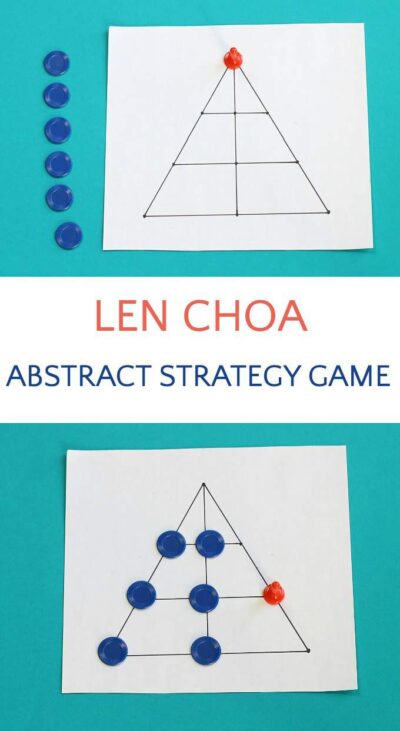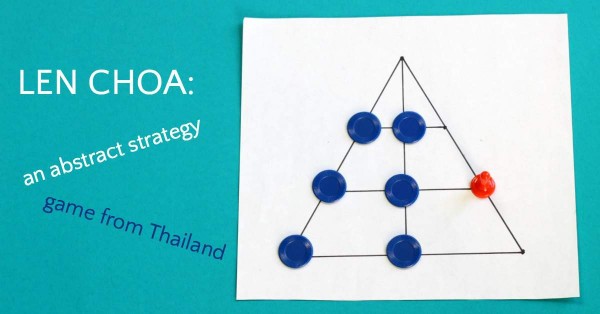There is a group of traditional abstract strategy games called "leopard hunt games." Since my kids and I have been playing other DIY abstract strategy games like Tapatan and Pong Hau K'i, we wanted to try a beginning leopards and tiger game. Len choa is a traditional game from Thailand and pits the tiger (the hunter) against six leopards (the hunted).
How to Play Len Choa
Game equipment:
- Triangular game board. Draw out an isosceles triangle. Bisect it from top to bottom and draw two lines across, as shown in the photo. Mark each intersection with a dot.
- Tokens. You need one token for the tiger, and six for the leopards. We pulled game pieces from other board games; you could also use coins.
Objective(s): The tiger attempts to capture the leopards by jumping over them (as in checkers). The leopards attempt to surround the tiger and block him so that he cannot move.
Game Play:
- Decide who will be the tiger and who will be the leopards.
- The first player positions the tiger at the top of the triangle.
- The second player places his first tiger at one of the dots the board, "the jungle", as we liked to call it.
- The tiger then moves along the lines, one dot at a time.
- Play alternates as the second player continues to place his leopards on the game board one at a time. He cannot move any of the leopards on the board until all six have been placed.
- Once all leopards are on the board, play continues to alternate between players.
- The tiger can jump over a leopard provided the dot on the opposite side of the leopard on the same line is free (as in checkers). The jumped leopard is removed from the board.
- Play continues until either the tiger is trapped and can no longer move or jump, or there are too few leopards to trap the tiger.
Watch the video to see it in action:
Notes on playing len choa:
Once the tiger has jumped a leopard, play can continue, but with skilled players, the game is unlikely to result in anything other than a tiger victory.
Ask kids how they think the starting position of the leopard contributes to success or defeat? For example, placing a leopard directly beneath the tiger will result in an immediate loss of token. (See the video.)
Try using seven or five leopards and see how the game changes!
An example of how the leopards can trap the tiger:
About Leopard Hunt Games:
Leopard hunt games, like len choa, are abstract strategy games (meaning there is no luck factor, as there is in poker) that originated in Southeast Asia. They all use a game board that contains a triangle, or version of a triangle bisected with lines and pit a hunter against a group of hunted animals. Other examples of leopard hunt games are hat diviyan keliya from Sri Lanka, and aadu puli aatam from South India. They are similar to fox hunt games from England (coming soon to this blog!).
More DIY games for kids:
- Tapatan, a three in a row game from the Philippines
- Pong Hau K'i, a traditional board game from China
- Watermelon Chess, an abstract strategy game from China
- Dara, a traditional game from Nigeria. 3 in a row with a fun twist.
- Fox and Geese, a hunt game from Northern Europe
- Math tic tac toe
- Peg triangle solitaire game
- Tchucka ruma, a solitary mancala game from Indonesia
Can't get enough games to play with your kids? We regularly share games we buy and those we make. First, sign up for our weekly newsletter, and then go and all our game posts!







Rabia Mir says
Hi!! Would it be possible to get the templates for all these wonderful strategy games??
I am starting a strategy club in my school and I would like to have these so I can quickly make copies and laminate!
I am loving these games btw! I can't wait to integrate social studies, and math!
Lauren says
For which age is this game appropriate? Thanks
Erica says
That depends on the child. You can try it with 4 year olds on up. But some kids may not take to it until 6 and up.
Minnatullah says
Hi, I've a question, can the leopards or tiger move diagonally?
Erica says
They can only move along the lines.
johnhenry says
Fun game! You have a small error, though, in the instructions. You say the second player places his tiger on the board after the first player's first move. The second player has leopards.